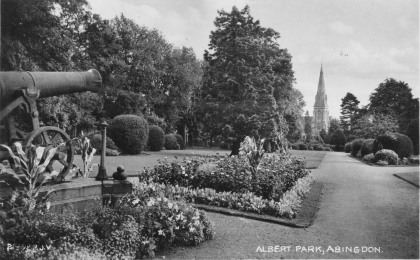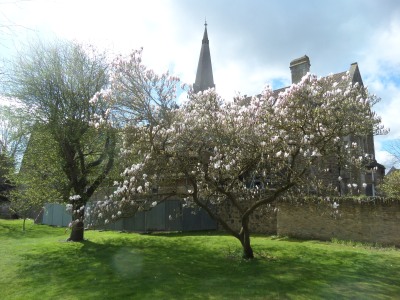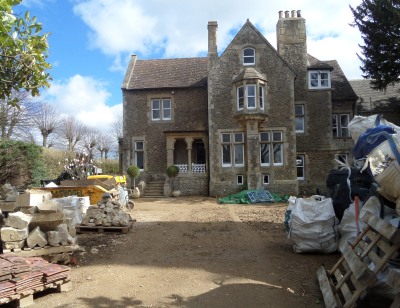
I have this old Valentine Post Card showing a cannon in Albert Park facing Trinity Church – a line of site that is nowadays obscured by bushes and trees. I think somebody said the cannon got melted down during WWII along with a lot of railings round the church.

Looking across the Abingdon School playing field, a magnolia partly hides the church and Trinity House, next door, which now has a new two storey extension and is being sympathetically refurbished.

According to D.B.Tranter’s History of Trinity, John Creemer Clarke ( a founding member of Trinity, clothing manufacturer, and MP) bought Trinity House on a nine-hundred year lease in 1873 for use as a church manse, and when he died it was given in trust to the Church and served as manse until the 1970s.
From that time it has been a private home, unlike a lot of the large houses round Albert Park which are too big for modern families.
it did indeed get melted down, along with its partner that stood to the right of the arch leading to the Abbey (where the music room is now) they were brought back from Sevastopol after the Crimean war, the one in the picture stood on a brick and concrete plinth in front of the Bowing club and had the inscription “Sevastopol” on it, although the cannon went 70 years ago, the plinth remained for many more years. Also in WW2 most if not all the iron railing belonging to houses in that area were taken too.
We used to climb over the plinth on our way to and from town in the 1970s–always easier on the way to town as the ground sloped away (and a bigger jump off it too). My father would quiz us on where Sevastopol was, and we weren’t allowed to jump off until we could tell him something factual about the Crimean War. Ah me! The perils of being a history master’s daughter …
yes, our children used to jump off this plinth into our arms for fun. I never had realised what a terrible thing the siege had been – especially for the defenders. In typical British style we had celebrated it as a great “victory”!!.
Now Sebastopol is back in the news…
Hi John E, I was fortunate enough to spend a couple of weeks in the Ukraine/Crimea 2 years ago, it is the most humbling of places, although the people dress like you and I the housing is appalling and it is very, very poor, I stayed in Sevastopol & Balaclava and visited the spot where Raglan ordered the charge of the light brigade (where they cannon came from) Cannons to the right and cannons to the left, into the valley of death rode the 6oo, that was then, but now Putin has taken it back because of its natural harbours and the vast underground canal system that houses the Black Sea submarine fleet.
Steve, where did you get your info about the cannons?
I remember playing on it too very clearly; it was one of the features of the park for local kids in the 60s/70s; no cars round it then. We also used to pretend it was a boxing ring little realising its tragic connections.
We lived at Trinity House from 1969 to 1971whilst Peter was the minister of Trinity Church. Our three youngsters chose to sleep at the very top of the house, where it was bitterly cold in the winter. If I remember it was just the forty odd steps to climb, several times a day.
We too visited Sevastopel, Yalta in 2012. The Crimea the former summer paradise of the Slviet oligarchy was in a very poor state.the concert given to us by the Russian fleet was breathtakingly slick and polished
Hi Rachel, I can trace my family back to 1725 in Abingdon and over the years our family have built up a wealth of knowledge, photo’s and memorabilia of the town, I have a photo of the cannon in front of the Abbey arches, I’ll send you a copy if you like? stephen.king20@btopenworld.com
My first house was in “Teasdale” Terrace, in Bostock rd (once called Bostock Avenue) and the small wall that ran along the front of the houses (still there) shows the remnants of where the railings were before they were taken for war scrap along with the Cannons.
Dear Editor/Alastair
I feel that I should point out a fact of inaccuracy which is unusual with your consistenly accurate reporting. Over 90% of the houses in Albert Park are in family occupation so clearly they are not ‘too big for family occupation’. The four houses in the north east sector of Park Crescent are in institutional use owned by Abingdon School and used as teaching and administrative spaces. Number 17 Park Crescent, the largest house in the Park, has been didvided but all the other houses in Park Crescent are occupied by families as are almost all the houses in Park Road. This has been the case since the estate was developed from the 1860s onwards and it seems that once a family moves in, they stay there for many years. Residents have in the past and still do treasure these houses for family occupation and younger people regularly replace previous generations.